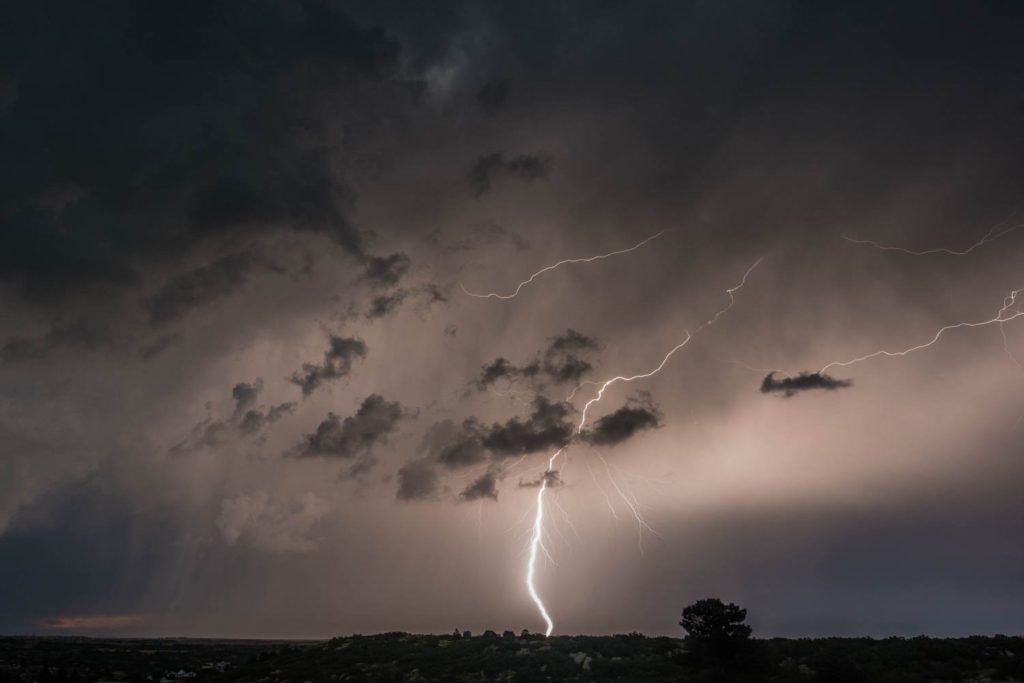
Colorado’s Lightning Season
The advent of spring, typically in March, heralds the onset of thunderstorms and lightning events. These meteorological phenomena intensify in the subsequent months of April and May. On an annual basis, the United States experiences approximately 446 million lightning pulses. Over half of these lightning events involve cloud-to-ground strikes, resulting in a minimum of 30 million locations impacted by lightning each year.
Florida holds the title of the “Lightning Capital” of the nation, with Four Corners, Florida, being the most lightning-prone area in the state. Colorado, however, also experiences a high frequency of lightning events due to its mountainous regions. These mountains play a crucial role in triggering thunderstorms from spring through fall. A typical thunderstorm day in Colorado commences with a sunny morning, followed by the formation of clouds over the mountains and foothills west of the I-25 corridor. As these clouds develop into thunderstorms, upper-level steering winds push the storms east onto the plains.
The formation of lightning is a complex process involving the interaction of water droplets and ice within storm clouds. Rising air currents within a storm transports water droplets towards the icy tops of cumulonimbus formations, where some droplets quickly freeze. The mixture of water and ice leads to the development of an electric charge. When these collide, water droplets freeze and release heat. This heat keeps the surface of hail and ice slightly warmer than their surrounding environment, forming a “soft hail”, or “graupel”. When graupel collides with additional water droplets and ice particles, electrons are sheared off the ascending particles, collecting on the descending particles. Because electrons carry a negative charge, the result is a storm cloud with a negatively charged base and a positively charged top. This process is essential for the development of an electric charge within the cloud.
When this charge accumulates sufficiently, a bolt of lightning extends from the cloud to the ground, discharging large amounts of electricity. In tropical regions, where the atmosphere maintains higher temperatures at greater altitudes, many storms can produce heavy rainfall but no lightning. Therefore, a low altitude freezing level (as is the case in Colorado) increases the number of lightning strikes observed along the Front Range. This low freezing level also contributes to the production of hail, a common occurrence in eastern Colorado.
Cloud-to-ground lightning can cause harm to people and animals, either directly or indirectly. The lightning current can branch off a tree, fence, pole, or other tall objects, electrocuting nearby humans or animals. Additionally, lightning strikes may conduct their current through the ground to a person after the lightning strikes a nearby object. The current may also travel through power lines, telephone lines, plumbing pipes, umbrella, or other conductors to a person who is in contact with these items. For instance, a golfer carrying a metal rod and wearing spiked shoes is at a heightened risk during a lightning event.
Over the past 30 years, lightning has caused an average of 28 deaths per year in the United States. This is higher than the average of 23 deaths per year caused by tornadoes, and the average of 17 deaths per year caused by hurricanes. However, because lightning usually affects only one or two victims at a time, and does not cause the mass destruction left in the wake of tornadoes or hurricanes, it generally receives less attention than these more destructive weather-related phenomena. While documented lightning injuries in the United States average about 300 per year, undocumented injuries caused by lightning are likely much higher.
In Colorado, a factor that often leads to a false sense of security and causes many people to remain outdoors for too long is the naturally dry air. Often, rain from thunderstorms evaporates before it reaches the ground. This phenomenon is known as virga. Lightning is still produced in these dry thunderstorms, but with no rain to drive people indoors, the tendency is to stay outside until it is too late. Additionally, lightning has been known to strike as far as 10 miles from the approaching storm. Therefore, even if it is not raining yet, it does not mean you are safe from lightning. It is always advisable to stay alert to changing weather conditions while you are outside and have a plan for seeking shelter if lightning becomes a threat.
For additional Information on Lightning Safety, visit the National Weather Service Lighting Safety page: https://www.weather.gov/safety/lightning
If you liked this article, check out Skyview Weather’s growing library of educational weather and climate content. Skyview Weather also offers comprehensive in-person and virtual weather education and weather safety training classes to ensure you and your staff are informed and prepared for severe, winter, and fire weather.
